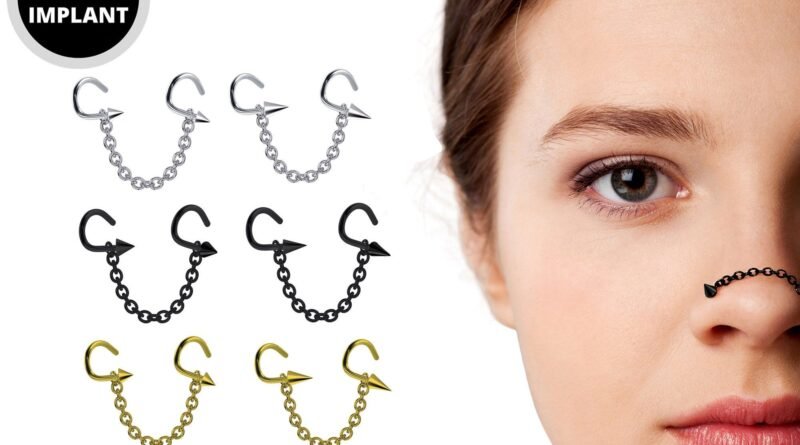Nasallang Piercing: The Unique and Bold Expression of Body Art
Nasallang Piercing: The Unique and Bold Expression of Body Art
In recent years, body piercing has transcended the realms of traditional earlobe piercing, evolving into an art form that embraces diverse styles, techniques, and placements. One of the most unique and striking forms of body piercing is the nasallang piercing. This daring piercing, located at the intersection of the nose and the nasal septum, has gained popularity for its bold aesthetic and distinct statement. In this article, we will explore the history, technique, aftercare, and cultural significance of nasallang piercing.
What is Nasallang Piercing?
A nasallang piercing involves the insertion of jewelry through the nostrils and the septum—the cartilage that divides the nasal passages. This piercing is unique because it requires a single entry point, making it distinct from other nasal piercings. It typically consists of a straight barbell, horseshoe, or circular jewelry, which runs through both nostrils and the septum simultaneously. The visual impact of a nasallang piercing is striking, as it showcases the jewelry prominently across the nose.
History of Nasallang Piercing
The nasallang piercing is not a modern invention; its origins can be traced back to various indigenous cultures around the world. Body piercing has been practiced for centuries, often serving as a rite of passage, a symbol of status, or a means of spiritual expression.
In many cultures, facial piercings are deeply embedded in tradition. For instance, in certain tribal communities, nostril and septum piercings symbolize bravery, maturity, and connection to one’s heritage. The nasallang piercing can be viewed as an evolution of these cultural practices, blending tradition with contemporary aesthetic preferences.
The Piercing Process
The process of getting a nasallang piercing requires careful consideration and should only be performed by a professional piercer with experience in this technique. Here’s a step-by-step overview of what to expect during the procedure:
- Consultation: Before the piercing, a consultation is essential. The piercer will discuss the procedure, jewelry options, and aftercare instructions. It’s also an opportunity for the individual to ask questions and express any concerns.
- Preparation: The piercer will clean the area around the nose and mark the entry and exit points for the jewelry. This step ensures proper alignment and placement, critical for achieving a symmetrical look.
- Piercing: It’s important to note that the piercer must be skilled to ensure the process is quick and minimizes discomfort.
- Inserting Jewelry: Once the holes are made, the piercer will carefully insert the chosen jewelry. Straight barbells or circular jewelry are common choices, but the selection ultimately depends on personal preference.
- Aftercare Instructions: After the piercing, the piercer will provide aftercare guidelines, which are crucial for preventing infection and promoting healing.
Aftercare for Nasallang Piercing
Proper aftercare is essential for a successful healing process and minimizing the risk of complications. Here are some key aftercare tips for nasallang piercings:
- Cleaning: Clean the piercing twice a day with a saline solution or a gentle, fragrance-free soap. Avoid using harsh antiseptics, as these can irritate the piercing.
- Avoid Touching: Refrain from touching or twisting the jewelry unnecessarily. This can introduce bacteria and lead to infections.
- Avoid Swimming: It’s best to avoid swimming pools, hot tubs, and bodies of water during the initial healing period to reduce the risk of infection.
- Be Mindful of Hair Products: Be cautious when using hair products or applying makeup around the nose, as these can irritate the piercing.
- Monitor for Infection: Keep an eye out for signs of infection, such as redness, swelling, or discharge. If any of these symptoms occur, consult a professional piercer or a healthcare provider.
Potential Risks and Complications
As with any body modification, there are potential risks associated with nasallang piercing. Some of these include:
- Infection: Improper aftercare or exposure to unsanitary conditions can lead to infections. It’s crucial to follow aftercare guidelines and seek help if signs of infection arise.
- Allergic Reactions: Some individuals may experience allergic reactions to certain metals used in jewelry. It’s advisable to choose high-quality, hypoallergenic materials, such as titanium or surgical stainless steel.
- Scarring: If not cared for properly, the piercing may lead to scarring or keloids, which are raised scars that can develop at the site of the piercing.
- Septal Perforation: There is a slight risk of damaging the nasal septum, which could result in complications such as septal perforation. This is why it’s crucial to choose a skilled piercer.
- Jewelry Migration: In some cases, jewelry may migrate from its original position, necessitating adjustments or re-piercing.
Cultural Significance
The nasallang piercing, like many body modifications, can carry cultural significance. In some cultures, nose piercings symbolize strength and connection to ancestry. For others, they represent a form of rebellion against societal norms or a means of self-expression.
Moreover, the growing acceptance of body piercings in mainstream culture has allowed individuals to explore body art without fear of judgment. The nasallang piercing embodies this spirit of individuality and self-expression, allowing wearers to showcase their personal style in a distinctive way.
Conclusion
The nasallang piercing is more than just a body modification; it is an expression of individuality, heritage, and personal style. With its rich history and growing popularity, this unique piercing continues to capture the attention of those seeking to make a bold statement. As with any piercing, it’s essential to approach the process with careful consideration, choose a skilled professional, and prioritize aftercare to ensure a healthy and successful healing journey. Whether seen as a cultural symbol or a fashion statement, the nasallang piercing remains a striking and fascinating form of body art that reflects the diversity of human expression.
